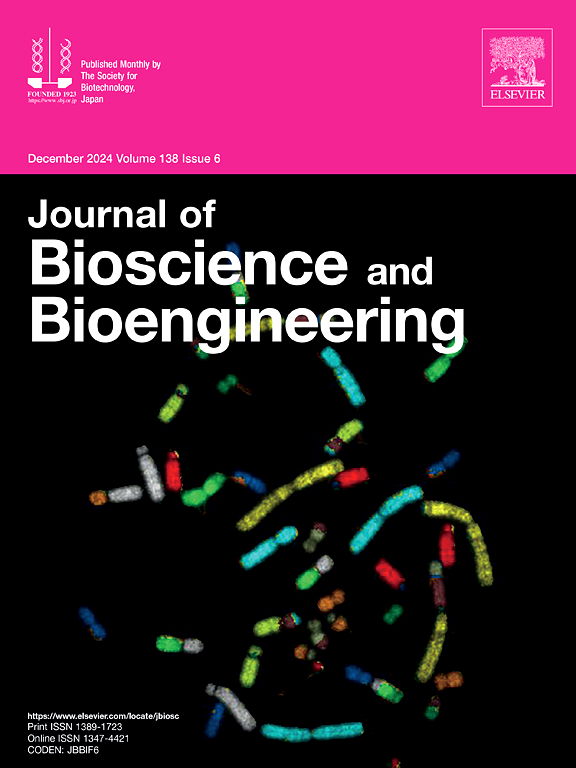由弹性蛋白样多肽衍生的温度响应水凝胶的可注射性。
IF 2.9
4区 生物学
Q3 BIOTECHNOLOGY & APPLIED MICROBIOLOGY
引用次数: 0
摘要
可注射水凝胶是一种很有前途的生物材料,用于组织工程应用,因为它们能够以最小的侵入性递送生物活性化合物或细胞。温度响应型原位胶凝水凝胶在温度刺激下从液体转变为凝胶,是可注射水凝胶的理想候选物。弹性蛋白样多肽(ELPs)由于其生物相容性、可生物降解性和可调节的机械性能,是众所周知的温度响应生物材料,可用于细胞支架、药物输送和组织工程。然而,由于高疏水性和非均相聚集,可注射水凝胶衍生的elp的发展仍然有限。在我们之前的研究中,我们设计了螺旋状单位结合的ELPs (CUBEs)水凝胶体系,该体系整合了ELPs、聚天冬氨酸(polyD)链、功能肽和螺旋状肽。在这项研究中,我们评估了基本CUBE水凝胶体系的可注射性和细胞递送潜力,称为O-CUBE (AVGVP)42-D88-CL。将O-CUBE蛋白溶液与人宫颈癌(HeLa)细胞混合,作为细胞模型,随后注射到预热至37℃的培养基中进行原位凝胶化。O-CUBE蛋白在37°C下注射后,在6-8的pH范围内以约90%的凝胶率成功凝胶化。被包裹的HeLa细胞呈现球形形态,表明水凝胶在三维培养中促进了细胞间的相互作用。进一步的DNA分析表明,HeLa细胞可以在水凝胶中存活和增殖。这些结果表明,CUBE水凝胶系统是一种很有前途的候选系统,可以以最小的侵入性递送细胞。本文章由计算机程序翻译,如有差异,请以英文原文为准。
Injectability of temperature-responsive hydrogel derived from elastin-like polypeptide for cell delivery
Injectable hydrogels are promising biomaterials for tissue engineering applications due to their ability to deliver bioactive compounds or cells with minimal invasiveness. Temperature-responsive in situ gelling hydrogels, which undergo transition from liquid to gel in response to temperature stimuli, are desirable candidates for injectable hydrogels. Elastin-like polypeptides (ELPs) are well-known temperature-responsive biomaterials for cell scaffolds, drug delivery, and tissue engineering, due to their biocompatibility, biodegradability, and tunable mechanical properties. However, due to high hydrophobicity and heterogeneous aggregation, the development of injectable hydrogel-derived ELPs remains limited. In our previous study, we designed coiled-coil unit-bound ELPs (CUBEs) hydrogel systems, which integrate ELPs, a polyaspartic acid (polyD) chain, a functional peptide, and a coiled-coil peptide. In this study, we evaluated the injectability and cell delivery potential of a basic CUBE hydrogel system, called O-CUBE (AVGVP)42-D88-CL. The O-CUBE protein solution was mixed with human cervical cancer (HeLa) cells, serving as a cell model, and subsequently injected into culture medium pre-warmed to 37 °C to initiate in situ gelation. O-CUBE protein was successfully gelled at an approximately 90 % gelation rate after injection at 37 °C within pH ranges of 6–8. Encapsulated HeLa cells exhibited spheroid morphology, indicating that the hydrogel facilitated cell–cell interactions in three-dimensional culture. Further evaluation using a DNA assay revealed that HeLa cells can survive and proliferate within the hydrogel. These results demonstrate that the CUBE hydrogel system is a promising candidate to deliver cells with minimal invasiveness.
求助全文
通过发布文献求助,成功后即可免费获取论文全文。
去求助
来源期刊

Journal of bioscience and bioengineering
生物-生物工程与应用微生物
CiteScore
5.90
自引率
3.60%
发文量
144
审稿时长
51 days
期刊介绍:
The Journal of Bioscience and Bioengineering is a research journal publishing original full-length research papers, reviews, and Letters to the Editor. The Journal is devoted to the advancement and dissemination of knowledge concerning fermentation technology, biochemical engineering, food technology and microbiology.
 求助内容:
求助内容: 应助结果提醒方式:
应助结果提醒方式:


